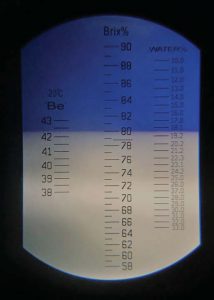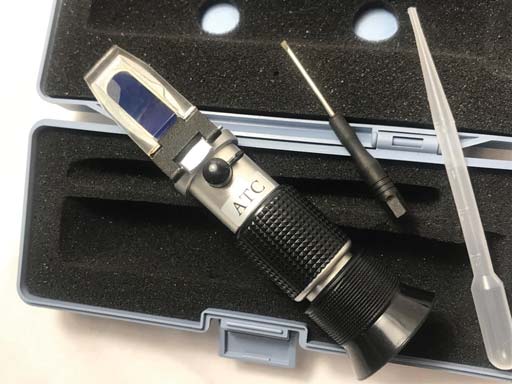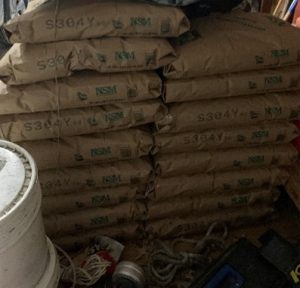By: Hanna Bäckmo
Honey typically contains somewhere between 14% – 20% water, seldom less, sometimes more. Honey contains lots of other substances as well, such as carbohydrates, mineral substances, enzymes, organic acids, proteins, and vitamins, but it is the water that we are going to concern ourselves with in this article. The water found in honey is mostly residual moisture after the process of nectar ripening. I say mostly, because as honey is hygroscopic, it absorbs moisture from its surrounds. If honey is stored incorrectly after extraction, its water content can increase. Frames of uncapped honey stored incorrectly prior to extraction can also absorb moisture and thus increase the water content of the honey. The percentage of water in honey depends on nectar origin, honey maturity and environmental factors such as climate, weather, and storage.
The water content of honey largely determines if the honey can stay fresh. The lower the water content, the better the honey will keep. As a beekeeper, being able to produce honey with the ‘right’ moisture content is imperative, particularly if you intend to sell your honey or store it. Honey with low moisture content will crystallize, or granulate, rapidly, but other than that it rarely gives any trouble. Where things go wrong is when honey with high moisture content is harvested and subsequently stored incorrectly, as this can lead to fermentation of the honey. This would render it unsuitable for resale as anything other than baker’s honey.
Fermentation
In order for fermentation to occur, three components need to be present. Yeasts, relatively high moisture content (in excess of 17%), and a suitable temperature for the yeasts to grow (10-30°C approximately). Take away at least one of these components and the honey will not ferment. For instance, store the honey below 10°C and/or ensure that the moisture content is low. You can kill the yeasts by heating the honey also, but this is not recommended as the heating process will destroy or reduce the effect of the enzymes present in honey, as well as altering the flavour. Yeasts are brought into the hive with the nectar. Many yeasts will die when the nectar is dried out and the sugar concentration rises. However, some remain in the honey. You will find the greatest amount of yeasts in uncapped or unripe honey, and it also contains more water than its capped or ripe counterpart. Yeast needs nitrogen and mineral salts to grow, which is why some honey which contains a lot of those substances will ferment faster.
There is no universally accepted number for what moisture content honey should have, but a good guide to aim for is somewhere between 16-18%. Below 17% moisture content, no fermentation will occur. At 18% no fermentation will occur unless there are large amounts of yeasts present. Above 19% moisture there is a definite danger of fermentation regardless of the amount of yeasts present. At 20% and over, yeasts will multiply freely, and the higher the moisture content, the more rapid the fermentation becomes.
This presents the need for the beekeeper to be able to accurately measure the moisture content in honey. In the apiary, we may do a simple shake-test to see if the honey is ripe enough to be harvested, (give frames of uncapped honey a good shake, if the honey comes out, it is not ready, and if it stays in the comb, it can be harvested and extracted alongside the capped frames). But when it comes to bottling and storing the honey, we need to be a bit more scientific than that.
Measuring moisture content in honey
When light passes through a substance, it changes direction. This is called refraction. The amount of refraction that the light undergoes depends on the amount or concentration of solids in the solution. A refractometer is an instrument that measures the refractive index of a substance, or, in layman’s terms, the degree that light, passing through a solution, is bent. By measuring the difference between the angle of the light coming in (incidence) and the angle of the light going out (refraction) of a substance you have the components needed to calculate the refractive index. If you look at a glass of water with a straw in it, you will notice that the straw looks as if it is bent or distorted. This is because the light passes through the glass more quickly than it does through the glass and water. Similarly, light will pass through honey with fewer solids faster than it will through honey with many solids. Hence, the refractive index of honey will change relative to the amount of sugars, pollen, and other substances present in the honey.
The refractometer is a very useful tool that measures the refractive index, does the calculations, and presents a reading. Refractometers are used not only by beekeepers. Different types of refractometers are used in other professions and industries such as medicine, brewing, machine- and car industries, gemology, and are used to measure salinity in aquariums, etc. The amount of solids in a solution is measured on a Brix scale, where each degree of Brix (°Bx) equals one percent solids (There are other scales also, but the Brix scale is used when measuring sugars). So, on a refractometer using the regular Brix scale, 20 degrees Brix means that the solution contains 20 percent solids. Anyone familiar with honey refractometers will be aware that they do not present the readings as solids in water, they work the opposite way and give measurements for water in solids. The scale works in reverse, and what we see is the water content of a solution as opposed to solid content. They are not designed this way to confuse, but to make the process of measuring moisture content in honey more straight forward for beekeepers, and more exact. The honey refractometer also does not commonly have the full 0-100 Brix scale, but typically displays values between 10-30 (% water) or 70-90 (% solids). Both a regular refractometer and a honey refractometer can be used to measure moisture content in honey, the only difference is how the results are read.
The refractive index will change slightly as the temperature changes so most refractometers are designed to make corrections based on temperature using Automatic Temperature Compensation, or ATC.
Different refractometers
If you are considering getting a refractometer to measure your honey, it is advisable to get a honey refractometer as opposed to a regular one. There are many honey refractometers available on the market, most are portable and easy to use. There are both analogue and digital instruments available, ranging in price from around 20 Euros or about $25US to several hundred and even thousands for laboratory style pieces. You can of course fork out for a top of the range digital version, but a standard analogue honey refractometer will give adequate readings. The readings will not be completely accurate but typically within one degree Brix, or 1 percent, fault margin, so will give a good indication of the moisture content in your honey, provided that the refractometer is used correctly and is calibrated properly.
Calibration
The first thing that you have to do with your refractometer is to calibrate it. By calibrating it, you are using a reference liquid or solution that you know the Brix reading of (or the moisture content) and adjust the instrument so that you get the same reading on its Brix scale. Some refractometers are already calibrated, but it is always good to re-calibrate it yourself first before using it to test your honey. The screw used to adjust the reading could have become loose in transport, and it is good practice to recalibrate your instrument after it has been unused for any length of time.
Reference solution

This is what you can see when you look into the eyepiece of a honey refractometer. The honey measured here has a moisture content of approximately 18.5%
When calibrating the refractometer, you need to make sure that you use a reference solution that is suitable for your particular instrument. For instance, if you are using a honey refractometer with a reduced Brix scale, such as 90-60 Brix (or 10-30% water) which is common for honey refractometers, you may have problems calibrating it accurately if your reference solution falls outside of those measurements. Many of the cheaper refractometers do not include any reference solution, and unfortunately many also come with the wrong instructions. It does not necessarily mean that there is anything wrong with the instrument itself, only that you have to do a bit more work to get it right. If you do not have a reference solution supplied with your instrument, it is possible to use oils that you have in your kitchen to calibrate your refractometer. For instance, extra virgin olive oil can be used, as can liquid paraffin. Extra virgin olive oil measures 71-72 Brix. If using this oil to calibrate, set it at 71.5 Brix (or 27% water). Liquid paraffin has a moisture content of 24.5%. If you are unsure of the moisture content or Brix reading of a substance, there is little point in attempting to use it as a reference solution. If, however, you are stuck and you happen to have access to someone who has a refractometer that is properly calibrated, you can use this instrument to determine the Brix of a substance, and then calibrate your own refractometer accordingly. This is obviously a cumbersome way to go about it, so it is easier just to ask them for a few drops of their reference solution if it falls within the Brix scale on your refractometer. It is always good to have a small bottle of reference solution stashed alongside the refractometer in your honey room. Write down the Brix or the moisture content on the bottle so that you do not have to rely on your memory, look it up or make guesstimations the next time you need to recalibrate.
This is how to calibrate an analogue refractometer (for digital versions, follow the instructions provided with the instrument):
• Lift the clear panel that sits on top of the glass and clean the glass or prism with a lint free cloth. Then add a couple of drops of the reference solution to the glass and spread it out. Make sure there are no air bubbles in the reference solution and close the panel. Any air can be squeezed out by gently pressing down the panel and wiggle it slightly.
• Remove the cover for the calibration adjustment piece and have the little screwdriver at the ready.
• Hold the refractometer towards a bright light and look through the eyepiece. Focus the eyepiece if necessary, to make the lines and numbers clearer. You should see a field of blue and another field of white, with a very distinct line where the two fields meet. This line marks the Brix of the substance measured.
• While still looking through the eyepiece, insert the screwdriver into the screw in the adjustment piece and turn it until the line correlates to the number for the known Brix reading of your chosen substance.
• Your instrument is now calibrated and ready to use. Replace the cover for the calibration adjustment piece and clean the clear panel and prism using a damp soft lint free cloth.
Refractometers need to be recalibrated regularly, at least every season but preferably more often as the instrument is sensitive. The adjustment screw can accidentally loosen during handling causing the reading to change, and it is also somewhat sensitive to changes in temperature.
How to use an analogue refractometer
Once properly calibrated, refractometers are delightfully easy to use. Make sure the honey is well stirred (honey that has been sitting in a bucket or jar for some time will often have different readings in the samples taken from the top and bottom) and that the honey is the same temperature as the refractometer, ideally room temperature.
• Lift the clear panel that sits on top of the glass and clean the glass or prism with a lint free cloth. Then add a couple of drops of honey to the glass and spread it out. Make sure there are no air bubbles in the honey and close the panel. Any air can be squeezed out by gently pressing down the panel and wiggle it slightly. Make sure not to put too much honey on the prism as it can make it difficult to get a clear reading.
• Hold the refractometer towards a bright light and look through the eyepiece. Focus the eyepiece if necessary. You should see a field of blue and another field of white, with a very distinct line or border where the two fields meet. In most analogue refractometers there is an ascending Brix scale in the middle, and a descending water content scale on the right. The line will go through both scales and thus you can read both the Brix and the water content in percent in the same reading.
• Clean the clear panel and prism using a moistened soft lint free cloth and repeat.
• Take multiple readings and calculate the average, especially if measuring the moisture content of a bucket or large amount of honey.
• If the honey is to be stored, write down the moisture content of the honey on the bucket alongside the batch number and extraction date.
• When finished, clean the refractometer, and put away in its box. Be careful with the prism as any scratches can impair or interfere with the readings.
In order to ensure that the honey does not contain excessive moisture, when harvesting make sure that the honey in the frames is ripe and take frames with capped honey only. It is nearly impossible to completely exclude uncapped honey when harvesting and extracting, particularly at the end of Summer harvest, and many beekeepers will include up to 10 percent of uncapped cells. Take off the honey supers in the morning so that the bees can dry out the honey over-night and to ensure that there is no new nectar coming in. If there are a lot of uncapped frames to be harvested and extracted, they can be dried out prior to extraction using a fan and/or dehumidifier. The honey can also be extracted and stored separately. Honey with high moisture content for own use is best frozen in jars and taken out as they are needed. Extracted honey with high moisture content can be placed on trays and dried using a fan and/or dehumidifier. Smaller amounts can also be mixed in with honey with low moisture content. If doing this, ensure that the end result is a honey that has no higher than 17-18% moisture content.
Finally, I would advise anyone who harvests honey to use a refractometer to measure the moisture content of the honey, whether it is for own consumption, gifts, or sale.
For any comments, feedback, or suggestions, please email Hannabackmo@yahoo.se
Reprinted with permission of “The Irish Beekeeper.”









